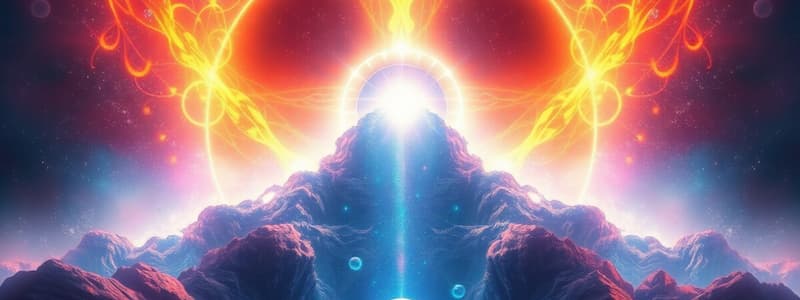Podcast
Questions and Answers
If an atom has 6 protons and 8 neutrons in its nucleus, and it gains two electrons, what is the resulting charge of the ion?
If an atom has 6 protons and 8 neutrons in its nucleus, and it gains two electrons, what is the resulting charge of the ion?
- +4
- +2
- Neutral (no charge)
- -2 (correct)
Which type of chemical bond involves the sharing of electrons between two atoms, leading to a stable electron configuration for both?
Which type of chemical bond involves the sharing of electrons between two atoms, leading to a stable electron configuration for both?
- Van der Waals force
- Hydrogen bond
- Ionic bond
- Covalent bond (correct)
In a solution of saltwater, which component is considered the solvent?
In a solution of saltwater, which component is considered the solvent?
- Neither salt nor water
- Salt (NaCl)
- Both salt and water
- Water (H2O) (correct)
If a solution has a pH of 3, how does its acidity compare to a solution with a pH of 6?
If a solution has a pH of 3, how does its acidity compare to a solution with a pH of 6?
Which of the following bonds is the weakest?
Which of the following bonds is the weakest?
Which subatomic particle primarily dictates the chemical behavior of an atom?
Which subatomic particle primarily dictates the chemical behavior of an atom?
If an atom has an atomic number of 6 and an atomic mass of 14, how many neutrons does it have?
If an atom has an atomic number of 6 and an atomic mass of 14, how many neutrons does it have?
What characteristic of radioactive isotopes makes them useful in research and medical applications?
What characteristic of radioactive isotopes makes them useful in research and medical applications?
Which element is a primary component of nucleic acids and ATP?
Which element is a primary component of nucleic acids and ATP?
What role does magnesium play in chlorophyll?
What role does magnesium play in chlorophyll?
Which of the following elements is commonly used in disinfectants and water purification?
Which of the following elements is commonly used in disinfectants and water purification?
Why is potassium essential for cell membrane permeability?
Why is potassium essential for cell membrane permeability?
What determines the valence of an element?
What determines the valence of an element?
Which type of bond involves the sharing of electrons between atoms?
Which type of bond involves the sharing of electrons between atoms?
What distinguishes a polar molecule from a nonpolar molecule?
What distinguishes a polar molecule from a nonpolar molecule?
In the context of atomic structure, what do electron orbitals represent?
In the context of atomic structure, what do electron orbitals represent?
How does a double covalent bond compare to a single covalent bond?
How does a double covalent bond compare to a single covalent bond?
What is the significance of sulfur in protein structure?
What is the significance of sulfur in protein structure?
How do isotopes of an element differ from each other?
How do isotopes of an element differ from each other?
Which element is necessary for the proper function of some enzymes and also used to treat fungal and worm infections?
Which element is necessary for the proper function of some enzymes and also used to treat fungal and worm infections?
Flashcards
Atom
Atom
The basic unit of matter; indivisible by chemical means.
Element
Element
A pure substance consisting only of atoms with the same atomic number.
Chemical Bond
Chemical Bond
The attractive force that holds atoms together.
Solute
Solute
Signup and view all the flashcards
Solvent
Solvent
Signup and view all the flashcards
Matter
Matter
Signup and view all the flashcards
Protons (p+)
Protons (p+)
Signup and view all the flashcards
Neutrons (n0)
Neutrons (n0)
Signup and view all the flashcards
Electrons (e-)
Electrons (e-)
Signup and view all the flashcards
Isotopes
Isotopes
Signup and view all the flashcards
Radioactive Isotopes
Radioactive Isotopes
Signup and view all the flashcards
Orbitals
Orbitals
Signup and view all the flashcards
Molecule
Molecule
Signup and view all the flashcards
Compound
Compound
Signup and view all the flashcards
Valence
Valence
Signup and view all the flashcards
Covalent Bonds
Covalent Bonds
Signup and view all the flashcards
Polar Molecule
Polar Molecule
Signup and view all the flashcards
Study Notes
Atoms, Bonds, and Molecules
- Matter is all tangible materials that occupy space and have mass.
- An atom is a tiny particle that cannot be subdivided into smaller substances without losing its properties.
Properties of Atoms
- Protons (p+) are positively charged and found in the nucleus.
- Neutrons (n°) have no charge and are also found in the nucleus.
- Electrons (e-) are negatively charged and surround the nucleus
Elements
- An element is an atom with a characteristic atomic structure and predictable chemical behavior.
- Isotopes are variant forms of the same element that differ in the number of neutrons.
- Radioactive isotopes have unstable nuclei that spontaneously release energy in the form of radiation, they are used in research and medical applications.
Key Elements and Their Significance
- Calcium (Ca): Atomic mass is 40.1, ionized form is Ca2+, part of outer covering of certain shelled amoebas or stored within bacteria.
- Carbon (C): Atomic mass is 12.0, ionized form is CO32-, is the principal structural component of biological molecules.
- Carbon-14 (C-14): Atomic mass is 14.0, is a radioactive isotope used in dating fossils.
- Chlorine (Cl): Atomic mass is 35.5, ionized form is CO-, is a component of disinfectants used in water purification
- Cobalt (Co): Atomic mass is 58.9, ionized form is Cr, a trace element needed by some bacteria to synthesize vitamins.
- Cobalt-60 (Co-60): Atomic mass is 60, ionized forms are Co2+ and Co3+, emits gamma rays, and is used in food sterilization and to treat cancer.
- Copper (Cu): Atomic mass is 63.5, ionized forms are Co2+ and Co3+, necessary for the function of some enzymes, and copper salts are used to treat fungal and worm infections.
- Hydrogen (H): Atomic mass is 1, ionized form is H+, necessary component of water and many organic molecules, H₂ gas released by bacterial metabolism.
- Hydrogen (H3): Atomic mass is 3, ionized form is H+, has two neutrons, radioactive, used in clinical laboratory procedures
- Iodine (I): Atomic mass is 126.9, ionized from is Γ, a component of antiseptics and disinfectants and is used in the Gram stain
- Iodine (I-131, I-125): Atomic mass is 131, 125, ionized from Γ, radioactive isotopes for diagnosis and treatment of cancers.
- Iron (Fe): Atomic mass is 55.8, ionized forms are Fe2+ and Fe3+, a necessary component of respiratory enzymes required by microbes to produce toxin.
- Magnesium (Mg): Atomic mass is 24.3, ionized form is Mg, trace element needed for some enzymes and component of chlorophyll pigment.
- Manganese (Mn): Atomic mass is 54.9, ionized form is Mg2+, a trace element for certain respiratory enzymes
- Nitrogen (N): Atomic mass is 14.0, ionized forms are Mn2+ and Mn3+, a component of all proteins and nucleic acids; the major atmospheric gas, and NO3-
- Oxygen (O): Atomic mass is 16.0, An essential component of many organic molecules; molecule used in metabolism by many organisms.
- Phosphorus (P): Atomic mass is 31, ionized from is PO43-, A component of ATP, nucleic acids, cell membranes; stored in granules in cells.
- Phosphorus (P-32): Atomic mass is 32, ionized from is PO43-, A radioactive isotope used as a diagnostic and therapeutic agent.
More Key Elements and Their Significance
- Potassium (K): Atomic mass is 39.1, ionized form is K+, Required for normal ribosome function and protein synthesis; essential for cell membrane permeability.
- Sodium (Na): Atomic mass is 23.0, ionized from is Na+, Necessary for transport; maintains osmotic pressure; used in food preservation.
- Sulfur (S): Atomic mass is 32.1, ionized from is SO4, Important component of proteins; makes disulfide bonds; storage element in many bacteria.
- Zinc (Zn): Atomic mass is 65.4, ionized from is Zn2+, An enzyme cofactor; required for protein synthesis and cell division; important in regulating DNA.
- Pathways in which electrons rotate around the nucleus
- Represent volumes of space in which an electron is likely to be found
Bonds and Molecules
- A molecule is a chemical substance that results from the combination of two or more atoms (e.g., O2, N2).
- A compound is a molecule composed of two or more different elements (e.g., H2O, C6H12O6).
- Chemical bonds result when two or more atoms share, donate (lose), or accept (gain) electrons.
- Valence is the number of electrons in the outermost shell of an element.
- Valence determines the degree of reactivity and the type of bonds an element can make.
Covalent Bonds
- Form between atoms that share electrons rather than donating or receiving them.
- Single covalent bonds share a pair of electrons (H2).
- Double covalent bonds share two pairs of electrons and are more rigid than single bonds (O2).
Polar and Nonpolar Molecules
- Polar molecules result when a molecule is formed between two atoms that have different electronegativity or ability to attract electrons.
- Nonpolar molecules are formed when atoms have similar electronegativity.
Studying That Suits You
Use AI to generate personalized quizzes and flashcards to suit your learning preferences.




